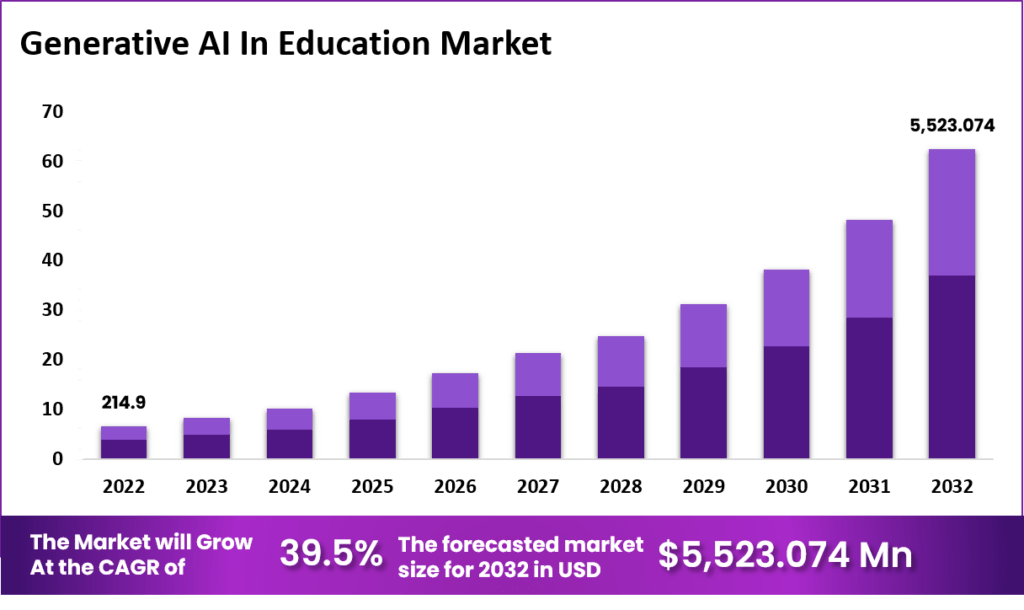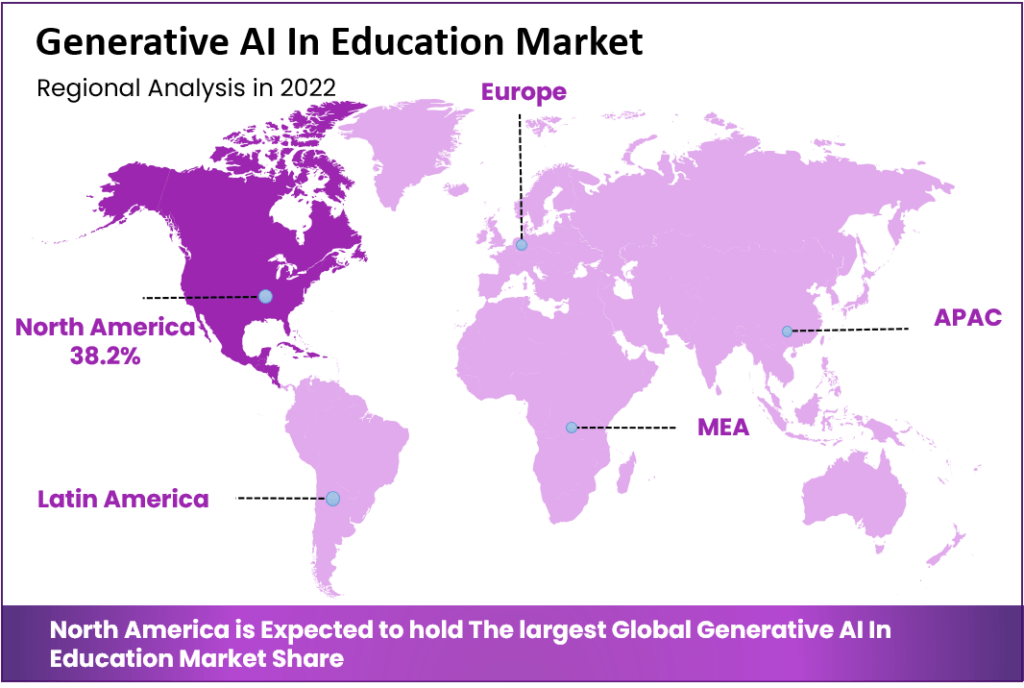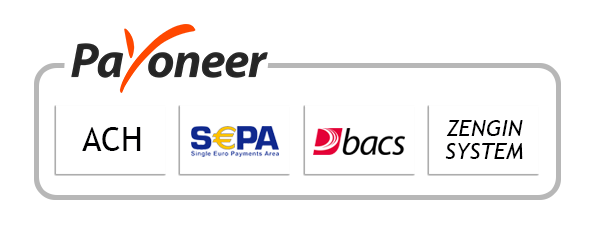
-
Report ID 138093 -
Published Date June 2023 -
Delivery Format PDF/PPT/Word -
Editor's Rating
-
Report Details
Market Overview
The Generative AI in Education market is anticipated to reach a value of approximately USD 5,523.074 million by 2032, up from USD 214.9 million in 2022, displaying a robust CAGR of 39.50% during the forecast period from 2023 to 2032. The market is being driven by the increasing demand for personalized learning, the need to improve student outcomes, and the growing popularity of online education.

Note – The number might vary in the actual report
Key Takeaways
- The market is expected to be driven by the increasing demand for personalized learning. Generative AI can be used to create personalized learning experiences for students by tailoring content, assessments, and feedback to their individual needs.
- The market is also expected to be driven by the need to improve student engagement. Generative AI can be used to create more engaging learning experiences by using interactive content, simulations, and games.
- The market is also expected to be driven by the rising adoption of online learning. Generative AI can be used to create more engaging and effective online learning experiences.
To gain a comprehensive understanding of the report, you can access a PDF sample that includes the complete table of contents, a list of exhibits, as well as selected illustrations and example pages.
Demand and Trend
The demand for Generative AI in Education is expected to be driven by the following trends:
- The increasing adoption of online learning
- The growing need for personalized learning
- The rising demand for STEM education
- The need to improve student engagement
Largest and Fastest Growing Market
The largest market for generative AI in education is the K-12 segment. This is due to the increasing demand for personalized learning and the growing adoption of BYOD policies in schools.
The fastest-growing market for generative AI in education is the higher education segment. This is due to the rising adoption of online learning and the growing need for personalized learning experiences.

Identify key segments and regions in the market. Download Sample Report
Prime Determinants of Growth
The following are the prime determinants of growth in the generative AI in education market:
- Increasing demand for personalized learning
- Need to improve student outcomes
- Growing popularity of online education
- Rising adoption of BYOD (bring your own device) policies in schools
- Growing investment in educational technology
Factors Affecting the Growth
- The availability of data
- The cost of developing and deploying generative AI solutions
- The regulatory environment
Generative AI is expected to play a larger role in the following areas of education
- Personalized learning
- Assessment
- Gamification
- Virtual reality
- Artificial intelligence-powered tutoring
Market Dynamics
Drivers
- The increasing demand for personalized learning
- The need to improve student engagement
- The rising adoption of online learning
Restraints
- The availability of data
- The cost of developing and deploying generative AI solutions
- The regulatory environment
Opportunities
- The development of new generative AI-powered learning platforms
- The development of new generative AI-powered tools for teachers and students
- The investment in generative AI research by governments and educational institutions
Challenges
- The lack of awareness about generative AI
- The lack of skilled professionals to develop and deploy generative AI solutions
Key Players
- IBM Corporation
- Microsoft Corporation
- Google LLC
- Cognii Inc.
- Knewton
- Blackboard
- Metacog Inc.
- Duolingo
- Other Market Players
Recent Developments
- In 2022, Google launched a new AI-powered tool called AI for Education that can help teachers create personalized learning experiences for their students.
- In 2023, Microsoft announced that it is investing $1 billion in AI for education.
Market Segmentation
Based on Type
- Students
- Teachers
- Administrators
- Educational Institutions
- Other Types
Based on Application
- Adaptive Learning
- Content Generation
- Automated Grading
- Personalized Tutoring
- Virtual Simulations
- Intelligent Learning System
- Other Applications
Based on Technology
- Natural Language Processing
- Machine Learning
- Computer Vision
- Other Technologies
Based on Deployment Mode
- On-Premise
- Cloud-Based
Key Regions
- North America
- The US
- Canada
- Mexico
- Western Europe
- Germany
- France
- The UK
- Spain
- Italy
- Portugal
- Ireland
- Austria
- Switzerland
- Benelux
- Nordic
- Rest of Western Europe
- Eastern Europe
- Russia
- Poland
- The Czech Republic
- Greece
- Rest of Eastern Europe
- APAC
- China
- Japan
- South Korea
- India
- Australia & New Zealand
- Indonesia
- Malaysia
- Philippines
- Singapore
- Thailand
- Vietnam
- Rest of APAC
- Latin America
- Brazil
- Colombia
- Chile
- Argentina
- Costa Rica
- Rest of Latin America
- Middle East & Africa
- Algeria
- Egypt
- Israel
- Kuwait
- Nigeria
- Saudi Arabia
- South Africa
- Turkey
- United Arab Emirates
- Rest of MEA
Frequently Asked Questions
Q1. What is Generative AI in Education?
Generative AI in Education is a branch of artificial intelligence that focuses on creating new content, such as text, images, and videos, that are tailored to the specific needs of individual learners. This can be done by analyzing large amounts of data about the learner’s past performance, learning style, and interests.
Q2. What are the benefits of using Generative AI in Education?
There are many benefits to using Generative AI in Education, including:
- Personalized learning: Generative AI can create personalized learning experiences for each learner, which can help them learn more effectively.
- Increased engagement: Generative AI can create engaging and interactive learning experiences, which can help learners stay motivated.
- Improved performance: Generative AI can help learners improve their performance in school and on standardized tests.
- Reduced costs: Generative AI can help reduce the cost of education by automating many tasks that are currently done by teachers.
Q3. What are the challenges of using Generative AI in Education?
There are also some challenges associated with using Generative AI in Education, including:
- Data privacy: Generative AI requires large amounts of data about learners, which raises concerns about data privacy and security.
- Bias: Generative AI models can be biased, which can lead to unfair treatment of learners.
- Cost: Generative AI can be expensive to develop and implement.
Q4. What is the future of Generative AI in Education?
The future of Generative AI in Education is very promising. As the technology continues to develop, it will become more affordable and easier to use. This will make it possible for more schools and teachers to use generative AI to improve the learning experience for their students.
-
Table Of Content
Research Insights & Deliverables
 Development and Future Forecast
Development and Future Forecast Competitive benchmarking
Competitive benchmarking Company Revenue Statistics
Company Revenue Statistics Rising Regional Opportunities
Rising Regional Opportunities Technology Trends and Dynamics
Technology Trends and Dynamics Technology Assessment
Technology Assessment
-
Inquiry Before Buying
Research Insights & Deliverables
 Development and Future Forecast
Development and Future Forecast Competitive benchmarking
Competitive benchmarking Company Revenue Statistics
Company Revenue Statistics Rising Regional Opportunities
Rising Regional Opportunities Technology Trends and Dynamics
Technology Trends and Dynamics Technology Assessment
Technology Assessment
-
Request Sample
Research Insights & Deliverables
 Development and Future Forecast
Development and Future Forecast Competitive benchmarking
Competitive benchmarking Company Revenue Statistics
Company Revenue Statistics Rising Regional Opportunities
Rising Regional Opportunities Technology Trends and Dynamics
Technology Trends and Dynamics Technology Assessment
Technology Assessment














